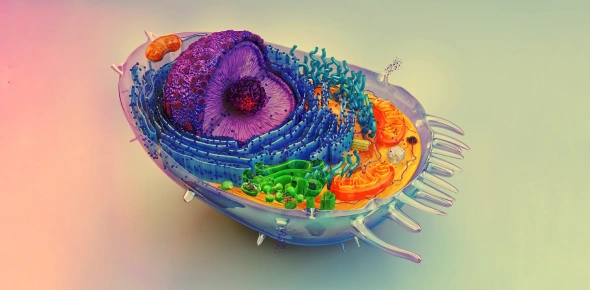What Is Introduction to Cells Structure, Function, and Cell Cycle? Explore Its Types, Uses & More
Lesson Overview
Cells are the basic structural and functional units of life. All living organisms are made up of cells, which is why the cell is often called the fundamental unit of life. Understanding cells is fundamental to biology, as cellular structures and processes underlie how organisms function and reproduce.
This lesson covers key concepts of cell biology, including the hierarchy of biological organization (from cells to whole organisms), differences between plant and animal cells, the roles of the cell membrane and cell wall, how chromosomes carry hereditary information, the mechanisms of osmosis and other forms of cell transport, the stages of the cell cycle (with focus on interphase and metaphase of mitosis), and how mitochondria produce energy for the cell.
Biological Levels of Organization
Multicellular life is organized in a hierarchy of levels from the smallest units up to the entire organism. Each level builds on the previous one:
- Cell: The smallest unit of life, capable of independent function. (Example: a muscle cell or a leaf cell.)
- Tissue: A group of similar cells that work together to perform a specific function. (Example: muscle tissue composed of many muscle cells.)
- Organ: A body part made of multiple tissue types working together for a common function. (Example: the heart, which includes muscle and nerve tissues.)
- Organ System: A group of organs that collaborate to carry out broad physiological functions. (Example: the circulatory system, which includes the heart, blood, and blood vessels.)
- Organism: A whole living being composed of multiple organ systems functioning together. (Example: a human or a tree.)
Each higher level incorporates the levels below it. For instance, cells form tissues, tissues form organs, organs form organ systems, and organ systems make up the complete organism.
Differences Between Plant and Animal Cells
Plant and animal cells are both eukaryotic (they have a nucleus and other membrane-bound organelles), but they have key structural differences adapted to their different life strategies:
- Cell Wall: Plant cells have a rigid cell wall outside the cell membrane, whereas animal cells do not. The plant cell wall (made of cellulose) provides structural support, helping the cell maintain a fixed shape and protecting it from bursting if excess water flows in. Animal cells lack a cell wall, which makes them more flexible and able to adopt varied shapes (useful for movement).
- Chloroplasts: Plant cells contain chloroplasts – organelles that carry out photosynthesis (using sunlight to produce sugars). Animal cells have no chloroplasts (animals must consume food to obtain energy rather than produce it from light).
- Vacuoles: Plant cells typically have a single large central vacuole that stores water, nutrients, and waste, and helps maintain cell pressure (turgor). Animal cells often have many small vacuoles or none that are prominent.
- Shape: Due to the rigid wall, plant cells often have a more regular, rectangular shape. Animal cells, lacking a cell wall, tend to have a rounder or irregular shape.
Cell Membrane and Cell Wall
Cell Membrane: The cell membrane (plasma membrane) is a thin, flexible barrier found in all cells. It is composed of a phospholipid bilayer with embedded proteins. The cell membrane's primary function is to control what enters and leaves the cell, maintaining the internal environment.
It is selectively permeable, allowing certain substances to pass through (such as water, oxygen, and nutrients) while restricting others. The cell membrane also protects the cell's contents and allows cells to communicate with their surroundings.
Cell Wall: The cell wall is a sturdy outer layer present in plant cells (but not in animal cells). In plants, the cell wall is made largely of cellulose. It provides structural support and protection for the cell. The rigidity of the wall helps plant cells maintain their shape and prevents them from bursting when they take up excess water by osmosis.
The cell wall is porous, allowing water and small molecules to freely pass, but together with the underlying cell membrane it ensures the cell maintains proper pressure and shape. The cell wall acts like an external skeleton for plant cells, whereas the cell membrane is the flexible gatekeeper present in all cells.
Chromosomes and Inheritance
Inside the nucleus of eukaryotic cells, DNA is packaged into structures called chromosomes. Chromosomes carry genetic information in the form of genes, which determine an organism's traits. Each chromosome is a long DNA molecule wrapped around proteins, containing many genes.
When cells divide to produce new cells (for example, when the body's cells divide for growth or repair), the chromosomes are copied (DNA replication) and then evenly separated into the two new cells. This ensures that each daughter cell receives the same set of genetic instructions as the parent cell. In this way, chromosomes pass on traits from the original cell to the new cells.
In sexual reproduction, offspring inherit chromosomes from both parents, which is why children share traits with their parents. Chromosomes thus serve as the carriers of hereditary information from one generation to the next.
Osmosis and Cell Transport
Cells must exchange substances (such as nutrients, gases, and wastes) with their environment, and this occurs through the cell membrane via several transport mechanisms. Some transport processes do not require energy (passive transport), while others do require energy (active transport).
- Diffusion: Diffusion is the passive movement of molecules from an area of higher concentration to an area of lower concentration. For example, oxygen molecules diffuse from the air (where oxygen is more concentrated) into a cell (where oxygen is less concentrated) without any energy input. Molecules naturally spread out in this way until their concentration is balanced on both sides of the membrane.
- Osmosis: Osmosis is the diffusion of water across a semipermeable membrane from a region of higher water concentration to a region of lower water concentration. In other words, water moves from a more dilute solution (low solute concentration) to a more concentrated solution (high solute concentration) across the membrane. Osmosis is crucial for maintaining cellular water balance. For instance, if an animal cell is placed in pure water, water will enter the cell by osmosis, potentially causing the cell to swell and burst (since it lacks a cell wall). A plant cell in the same situation will also take in water, but its sturdy cell wall prevents it from bursting; instead, the cell becomes turgid (firm).
- Active Transport: Active transport is the movement of substances across the cell membrane against their concentration gradient (from lower to higher concentration) using energy (ATP). This allows cells to accumulate needed substances or expel waste even when diffusion would not favor it. For example, nerve cells pump sodium ions out of the cell and potassium ions in, against their natural concentration gradients, by using a membrane protein (the sodium-potassium pump) powered by ATP. Active transport enables cells to maintain internal concentrations of ions and molecules that differ from those in their environment, which is vital for homeostasis.
The Cell Cycle: Interphase and Mitosis
Cells undergo a repeating cycle of growth and division called the cell cycle. The cell cycle consists of a long preparation phase called interphase, followed by a division phase. In eukaryotic cells, division happens through mitosis (division of the nucleus) and subsequent cytokinesis (division of the cell's cytoplasm).
Interphase: Interphase is the phase of the cell cycle when the cell is not actively dividing, but it is a time of growth and preparation. During interphase, the cell grows in size, performs its normal functions, and duplicates its DNA (each chromosome is replicated so that there are two copies). Interphase is subdivided into stages (G1, S, and G2), but overall it ensures the cell has a complete set of DNA and enough cellular components to divide. Interphase often constitutes the majority of the cell's life cycle and is essential for a successful division.
Mitosis (focus on Metaphase): Mitosis is the process by which a cell separates its duplicated chromosomes into two identical sets, so that each daughter cell will have the same genetic material. Mitosis is divided into stages: prophase, metaphase, anaphase, and telophase. Metaphase is the stage in the middle of mitosis when all the chromosomes line up across the center (equator) of the cell, along an imaginary plane known as the metaphase plate. The chromosomes attach by their centromeres to spindle fibers (protein filaments that extend from each end of the cell).
Metaphase is critically important because this alignment ensures that when the sister chromatids are pulled apart in the next phase (anaphase), each new daughter cell will receive one copy of each chromosome. After metaphase, the cell proceeds to anaphase (the sister chromatids separate and move to opposite sides of the cell) and telophase (new nuclear membranes form around each set of chromosomes). Finally, the cell divides in two during cytokinesis, producing two genetically identical daughter cells. Overall, precise alignment during metaphase and the coordinated steps of mitosis guarantee that each new cell inherits a complete set of chromosomes.
Mitochondria and Energy Production
Cells require energy to carry out their functions, and mitochondria are the organelles responsible for producing that energy. Mitochondria are found in nearly all eukaryotic cells, both animal and plant. Their primary function is to convert the chemical energy stored in food molecules into adenosine triphosphate (ATP), the usable energy currency of the cell. This conversion process is called cellular respiration and it uses oxygen to break down nutrients like glucose, releasing energy that is captured in ATP.
The number of mitochondria in a cell varies with the cell's energy needs. Cells that have high energy demands (for example, muscle cells or heart cells) contain many mitochondria to supply sufficient ATP, whereas less active cells may have fewer mitochondria. Plant cells, despite having chloroplasts to make sugars via photosynthesis, also contain mitochondria to convert those sugars into ATP. In summary, mitochondria are vital for powering cellular activities, enabling processes such as movement, synthesis of molecules, and cell division by providing the necessary ATP energy.
Rate this lesson:
 Back to top
Back to top
.webp)

